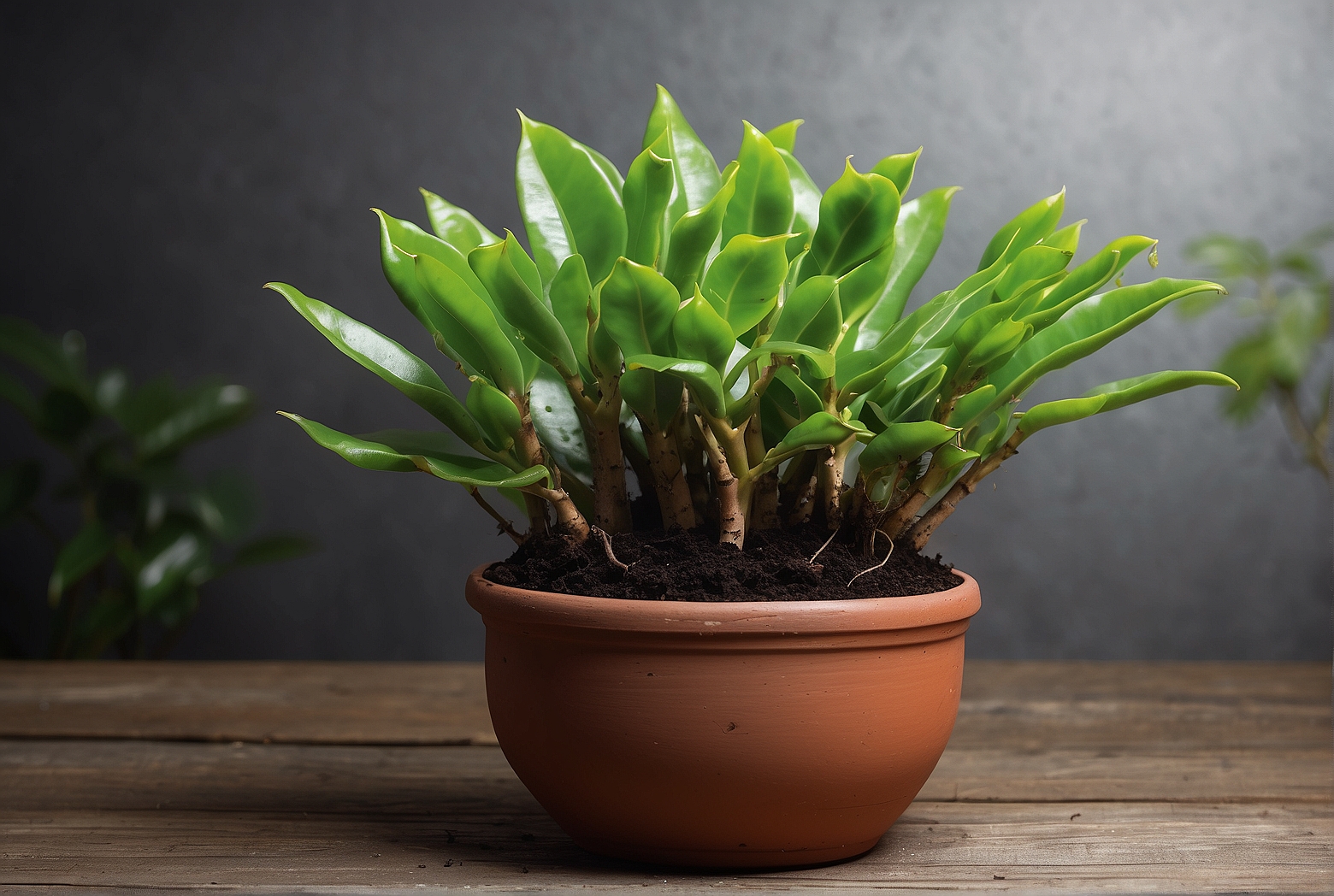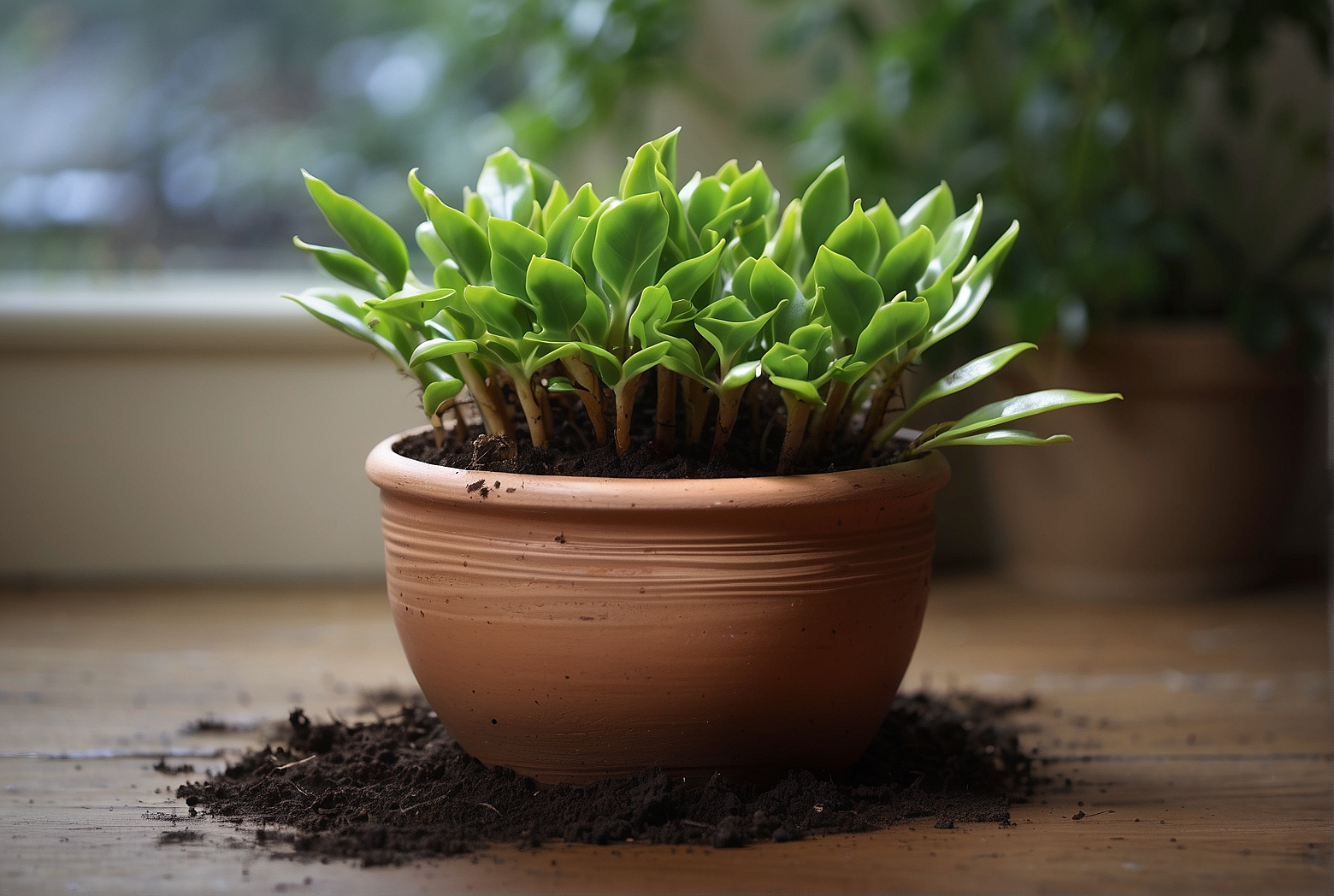Last Updated on April 2, 2024 by Tony Manhart
Do ZZ plants thrive when they’re root bound? You might be surprised to know that this popular houseplant species actually enjoys a bit of confinement in its pot. ZZ plants, also known as Zamioculcas zamiifolia, can tolerate a smaller container and limited root space quite well. In fact, being root bound can stimulate their growth and promote lusher foliage. So, if you’re wondering whether your ZZ plant needs to be repotted, keep reading to learn more about the benefits of letting it get a little cozy in its pot.
What is a ZZ Plant?
Description
The ZZ Plant, scientifically known as Zamioculcas zamiifolia, is a popular houseplant known for its attractive glossy green leaves. It is a member of the Araceae family and is native to Zanzibar, Kenya, and Eastern Africa. The plant is often referred to as the “eternity plant” due to its ability to thrive with minimal care.
Origin
The ZZ Plant originates from tropical regions of Africa and was first discovered in the late 1800s. It has since gained popularity as a houseplant across the globe due to its unique appearance and ability to withstand different environmental conditions.
Characteristics
ZZ Plants have thick, fleshy stems that grow in a graceful, upright manner. The leaves are dark green and shiny, with a waxy texture. The plant can grow to a height of two to three feet and has a slow growth rate. ZZ Plants are known for their ability to tolerate low light conditions and are ideal for indoor spaces with limited sunlight. Additionally, they are highly drought-tolerant and can survive long periods without water.

Understanding Root Bound Plants
Definition
A root-bound plant refers to a plant whose roots have outgrown their current container. As the plant grows, the roots become tightly packed and entangled, causing restricted growth and functionality. The roots may fill up the entire pot, making it difficult for them to expand and absorb nutrients properly.
Signs of being root bound
There are several signs that indicate a plant is root-bound. One common indicator is the appearance of roots protruding from the drainage holes at the bottom of the pot. Additionally, the plant may exhibit stunted growth, with leaves becoming smaller and yellowing. Reduced water absorption and an overall decline in plant health can also be signs of being root-bound.
Effects on plant health
When a ZZ Plant becomes root bound, its ability to take up water and nutrients from the soil is compromised. This can lead to a variety of negative effects on the plant’s health. The restricted root growth can result in nutrient deficiencies, as the roots are unable to access the necessary resources. Additionally, water uptake may be hindered, leading to overwatering or underwatering issues. Overall, being root bound can weaken the plant and make it more susceptible to diseases and pests.
How ZZ Plants React to Being Root Bound
Tolerance for being root bound
ZZ Plants have a high level of tolerance for being root bound. Due to their natural adaptation to dry and harsh conditions, they can withstand restricted root growth for extended periods. The plant has evolved to store water in its fleshy stems and leaves, allowing it to survive in low-nutrient environments. This unique feature enables ZZ Plants to thrive even when their roots are tightly packed.

Growth patterns
When a ZZ Plant becomes root bound, its growth patterns can change. Instead of growing taller, the plant may produce more lateral shoots, resulting in a bushier appearance. The leaves may also become smaller in size compared to a ZZ Plant with ample root space. Despite the restricted root growth, the plant can continue to produce new leaves and maintain its overall appearance.
Effects on overall plant health and appearance
While ZZ Plants can tolerate being root bound, it is important to monitor their overall health and appearance. A severely root-bound plant may exhibit signs of stress, such as wilting, yellowing leaves, and a decline in overall vigor. Regular care and observation are necessary to ensure the plant remains healthy and attractive.
Benefits of Keeping ZZ Plants Root Bound
Reduced need for repotting
One of the main benefits of keeping ZZ Plants root bound is the reduced need for repotting. As these plants can tolerate restricted root growth, they do not require frequent repotting like many other houseplants. This can be advantageous for individuals who prefer low-maintenance plants or have limited time for gardening tasks.
Promotes compact growth
Being root bound can promote compact growth in ZZ Plants. The limited space for root expansion encourages the plant to focus its energy on foliage production rather than upward growth. This can result in a denser and more visually appealing plant with lush green foliage.
Enhanced air purification capabilities
ZZ Plants have natural air purification capabilities, meaning they can help improve indoor air quality by removing toxins and pollutants. When kept root bound, the plant’s ability to filter the air can be enhanced. The concentrated root system, along with the plant’s resilience, contributes to its effectiveness in purifying the surrounding air.
Potential Drawbacks of Keeping ZZ Plants Root Bound
Risk of stunted growth
While ZZ Plants can tolerate being root bound, there is a risk of stunted growth if the root system becomes excessively crowded. If left unchecked, the plant may not reach its full potential in terms of size and height. Regular monitoring and timely interventions are essential to prevent this from happening.
Reduced nutrient availability
When a ZZ Plant is root bound, the confined root system may struggle to access sufficient nutrients from the soil. This can lead to nutrient deficiencies, resulting in weakened plant health and decreased vitality. Regular fertilization and providing nutrient-rich soil or compost can help mitigate this issue.
Increased susceptibility to diseases or pests
A root-bound ZZ Plant can be more vulnerable to diseases and pests. The limited root space makes it easier for harmful organisms to establish themselves and cause damage. It is important to regularly inspect the plant for any signs of infestation or disease and take appropriate measures to prevent or manage them.
Indications for Repotting ZZ Plants
Roots protruding from drainage holes
If you notice roots protruding from the drainage holes at the bottom of the pot, it is a clear indication that your ZZ Plant has become root bound. This is a sign that the current pot can no longer accommodate the growing root system, and it is time to repot the plant.
Water not being absorbed properly
Another indication that a ZZ Plant needs repotting is when it no longer absorbs water properly. If you notice that water tends to sit on the surface of the soil instead of being absorbed, it may be a result of the limited space for the roots to take up water. Repotting can provide the roots with more room to efficiently absorb water.
Plant becoming top-heavy
If your ZZ Plant starts to lean or become unstable in its current pot, it may be a sign that the plant has outgrown its container. When the plant becomes top-heavy, it is an indication that the root system needs more space and stability to support the plant’s growth.
How to Repot ZZ Plants
Choosing the right pot
When repotting a ZZ Plant, it is important to choose a pot that is one size larger than the current one. Select a pot with good drainage holes to ensure excess water can easily escape. The material of the pot can vary, but clay or ceramic pots are often preferred due to their breathability.
Preparing the new potting mix
Prepare a well-draining potting mix suitable for ZZ Plants. A combination of regular potting soil, perlite, and peat moss can provide the necessary drainage while still retaining some moisture. Avoid using heavy or compacted soil, as it can hinder root growth.
Carefully removing the plant from the old pot
Gently tip the ZZ Plant on its side and tap the pot to loosen the roots. Slowly and carefully slide the plant out of the pot, supporting the base of the plant with your hand. Be cautious not to damage the roots or break any stems during the removal process.
Inspecting and pruning the roots
Inspect the roots for any signs of damage, decay, or excessive circling. If you notice any unhealthy or overcrowded roots, carefully trim them with clean and sharp pruning shears. This will encourage healthy regrowth and prevent potential issues in the future.
Placing the plant in the new pot
Place a layer of fresh potting mix at the bottom of the new pot. Position the ZZ Plant in the center and gradually add more potting mix around the roots, ensuring they are adequately covered. Gently press the soil to secure the plant in place, but avoid compacting it too much.
Watering and post-repotting care
After repotting, thoroughly water the ZZ Plant to settle the soil and hydrate the roots. Place the plant in a bright, indirect light location and avoid direct sunlight for a few days to minimize stress. Maintain regular watering and monitor the plant’s growth and overall health in the following weeks.
Alternative Approaches for Root Bound ZZ Plants
Root pruning
Root pruning is a technique that involves selectively trimming the roots of a root-bound ZZ Plant. By removing a portion of the overcrowded roots, the plant’s root system can be rejuvenated. This approach is best done during repotting and can help promote healthier root growth.
Top-dressing with fresh soil
If repotting is not possible or desired, top-dressing with fresh soil can help provide some relief for a root-bound ZZ Plant. Carefully remove the top layer of soil and replace it with a nutrient-rich potting mix. This can help replenish some of the depleted nutrients and promote better root health.
Dividing into smaller plants
For severely root-bound ZZ Plants, dividing them into smaller plants can be an effective solution. Carefully remove the plant from its pot and gently separate the roots into multiple sections, ensuring each division has a healthy root system and foliage. Repot each division into separate containers with fresh soil and provide appropriate care.
Conclusion
In conclusion, ZZ Plants have a unique ability to thrive when root bound, thanks to their adaptation to harsh environments. Keeping these plants root bound offers several benefits, including reduced repotting needs, compact growth, and enhanced air purification capabilities. However, there are potential drawbacks to consider, such as stunted growth and reduced nutrient availability. Regular monitoring and timely interventions are essential to maintain the health and appearance of ZZ Plants. When indications for repotting arise, following the proper repotting process, or exploring alternative approaches like root pruning or top-dressing, can ensure the continued well-being of these beautiful and resilient houseplants.
Tony Manhart is a passionate gardener who has been tending to gardens for over 20 years. He takes pride in creating beautiful outdoor spaces with plants, trees, and shrubs that can thrive in any environment. He loves to share his knowledge with others and has taught classes on gardening basics and advanced techniques. He is committed to sustainability, using natural and organic methods to create and maintain gardens. He also works with local organizations to create green spaces for communities. When he’s not gardening, Tony enjoys hiking, reading, and spending time with his family.


